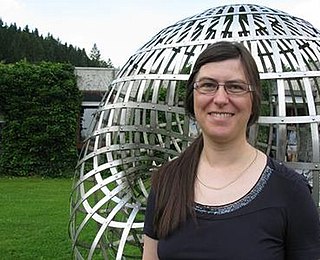In mathematics, class field theory (CFT) is the fundamental branch of algebraic number theory whose goal is to describe all the abelian Galois extensions of local and global fields using objects associated to the ground field.

Pierre René, Viscount Deligne is a Belgian mathematician. He is best known for work on the Weil conjectures, leading to a complete proof in 1973. He is the winner of the 2013 Abel Prize, 2008 Wolf Prize, 1988 Crafoord Prize, and 1978 Fields Medal.
In number theory, Iwasawa theory is the study of objects of arithmetic interest over infinite towers of number fields. It began as a Galois module theory of ideal class groups, initiated by Kenkichi Iwasawa (1959), as part of the theory of cyclotomic fields. In the early 1970s, Barry Mazur considered generalizations of Iwasawa theory to abelian varieties. More recently, Ralph Greenberg has proposed an Iwasawa theory for motives.
The mathematical term perverse sheaves refers to the objects of certain abelian categories associated to topological spaces, which may be a real or complex manifold, or more general topologically stratified spaces, possibly singular.
Hilbert's twelfth problem is the extension of the Kronecker–Weber theorem on abelian extensions of the rational numbers, to any base number field. It is one of the 23 mathematical Hilbert problems and asks for analogues of the roots of unity that generate a whole family of further number fields, analogously to the cyclotomic fields and their subfields. Leopold Kronecker described the complex multiplication issue as his liebster Jugendtraum, or "dearest dream of his youth", so the problem is also known as Kronecker's Jugendtraum.
In number theory, the Stark conjectures, introduced by Stark and later expanded by Tate (1984), give conjectural information about the coefficient of the leading term in the Taylor expansion of an Artin L-function associated with a Galois extension K/k of algebraic number fields. The conjectures generalize the analytic class number formula expressing the leading coefficient of the Taylor series for the Dedekind zeta function of a number field as the product of a regulator related to S-units of the field and a rational number.
In mathematics, the standard conjectures about algebraic cycles are several conjectures describing the relationship of algebraic cycles and Weil cohomology theories. One of the original applications of these conjectures, envisaged by Alexander Grothendieck, was to prove that his construction of pure motives gave an abelian category that is semisimple. Moreover, as he pointed out, the standard conjectures also imply the hardest part of the Weil conjectures, namely the "Riemann hypothesis" conjecture that remained open at the end of the 1960s and was proved later by Pierre Deligne; for details on the link between Weil and standard conjectures, see Kleiman (1968). The standard conjectures remain open problems, so that their application gives only conditional proofs of results. In quite a few cases, including that of the Weil conjectures, other methods have been found to prove such results unconditionally.
Cristian Dumitru Popescu is a Romanian-American mathematician at the University of California, San Diego. His research interests are in algebraic number theory, and in particular, in special values of L-functions.
The Brumer–Stark conjecture is a conjecture in algebraic number theory giving a rough generalization of both the analytic class number formula for Dedekind zeta functions, and also of Stickelberger's theorem about the factorization of Gauss sums. It is named after Armand Brumer and Harold Stark.
In algebraic number theory, an equivariant Artin L-function is a function associated to a finite Galois extension of global fields created by packaging together the various Artin L-functions associated with the extension. Each extension has many traditional Artin L-functions associated with it, corresponding to the characters of representations of the Galois group. By contrast, each extension has a unique corresponding equivariant L-function.
In mathematics, the main conjecture of Iwasawa theory is a deep relationship between p-adic L-functions and ideal class groups of cyclotomic fields, proved by Kenkichi Iwasawa for primes satisfying the Kummer–Vandiver conjecture and proved for all primes by Mazur and Wiles (1984). The Herbrand–Ribet theorem and the Gras conjecture are both easy consequences of the main conjecture. There are several generalizations of the main conjecture, to totally real fields, CM fields, elliptic curves, and so on.
Matthias Flach is a German mathematician, professor and former executive officer for mathematics at California Institute of Technology.
In mathematics, the study of special values of L-functions is a subfield of number theory devoted to generalising formulae such as the Leibniz formula for pi, namely

Annette Huber-Klawitter is a German mathematician at the University of Freiburg. Her research interests includes algebraic geometry, in particular the Bloch–Kato conjectures.
In algebraic number theory, the Ferrero–Washington theorem states that Iwasawa's μ-invariant vanishes for cyclotomic Zp-extensions of abelian algebraic number fields. It was first proved by Ferrero & Washington (1979). A different proof was given by Sinnott (1984).

Alexander Nikolaevich Varchenko is a Soviet and Russian mathematician working in geometry, topology, combinatorics and mathematical physics.

Aleksei Nikolaevich Parshin was a Russian mathematician, specializing in arithmetic geometry. He is most well-known for his role in the proof of the Mordell conjecture.
Gabriele Vezzosi is an Italian mathematician, born in Florence (Italy). His main interest is algebraic geometry.
Christopher McLean Skinner is an American mathematician working in number theory and arithmetic aspects of the Langlands program. He specialises in algebraic number theory.
Samit Dasgupta is a professor of mathematics at Duke University working in algebraic number theory.





